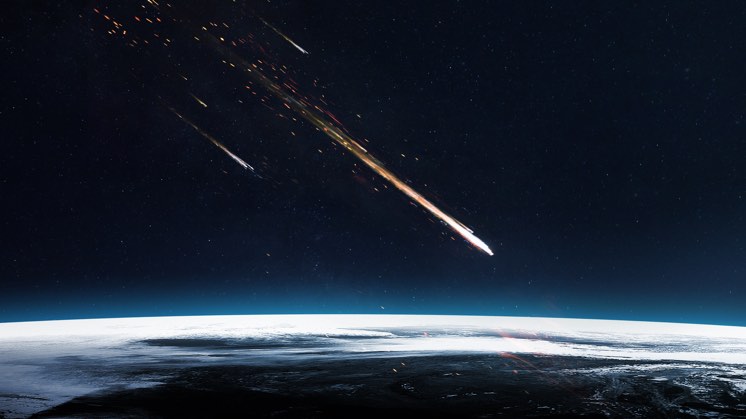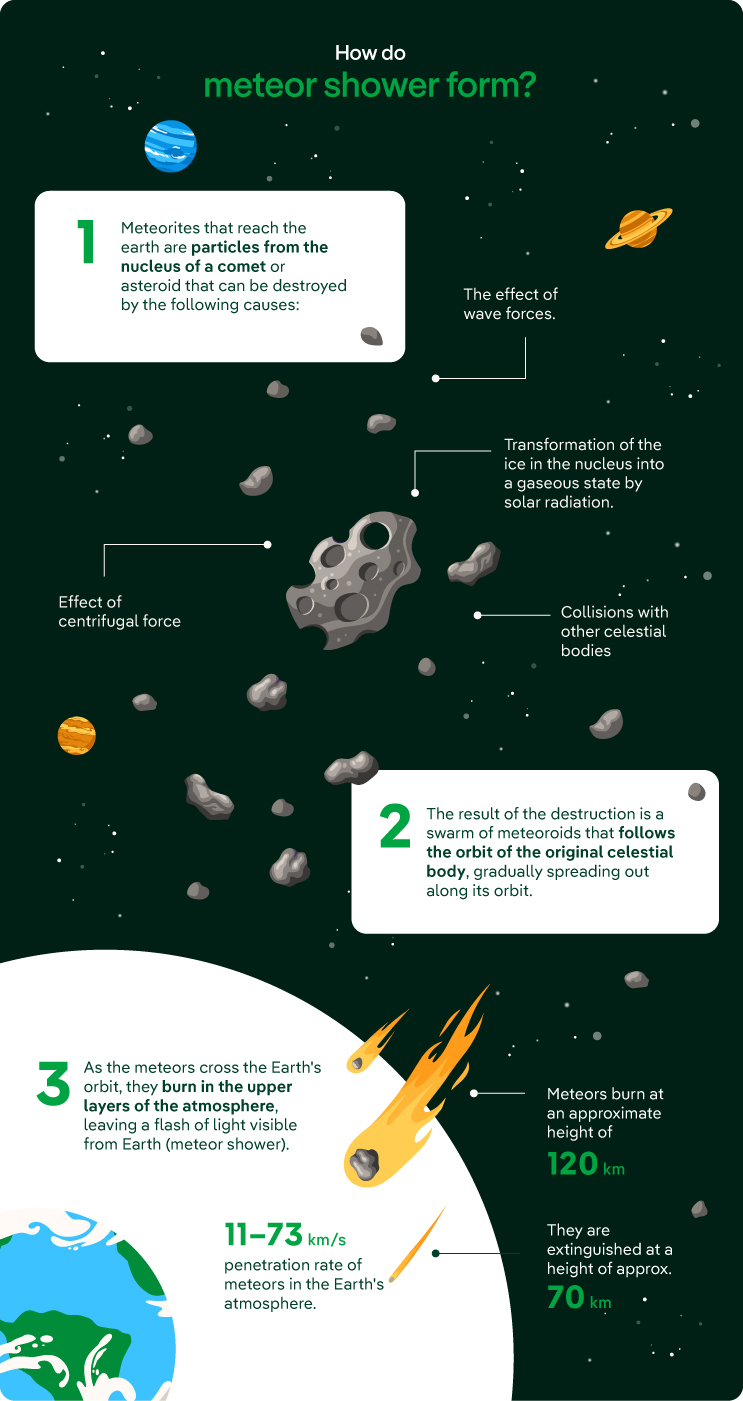Meteorite fallen on Earth
Meteorites on Earth: how many fall per year and why don't we see them?
You may never have actually seen a meteorite, but they keep falling to earth. According to a study by researchers at the University of Manchester and Imperial College published in Geology, there are about 17,000 of them a year. One reason for their apparent invisibility is their size, which shrinks after passing through the Earth's atmosphere to the point at which they are virtually imperceptible.

Most meteorites reach the Earth's surface in the form of dust or very small particles after passing through the atmosphere, which is why we do not normally see them. However, believe it or not, some 17,000 meteorites fall to Earth every year. The data comes from a team of researchers at the University of Manchester and Imperial College London, who have managed to quantify the flow of space material falling onto the planet between 2019 and 2020. According to Professor Geoffrey Evatt, who led the research, the fragments counted weighed between 50 grammes and 10 kilos (the latter is very rare).
What is a meteorite?
According to NASA, a meteorite is a space rock that reaches the Earth's atmosphere and survives the journey to the surface. The term meteorite is often confused with other terms such as meteor and meteoroid, with which it is related:
- Meteoroid: comet or asteroid rock particles with diameters ranging from centimetres to metres that orbit in space. It is the name given to a meteorite that has not yet entered into contact with the atmosphere.
- Meteor: occurs when a meteoroid passes through atmosphere, burning and disintegrating - after which it is considered to be a meteorite. When the light trail persists, it gives rise to what are commonly known as shooting stars.
Difference between meteorites and asteroids
People often confuse meteorites and asteroids. An asteroid is a rocky or metallic body that orbits the sun or another gravitational source in space. It is larger than a meteorite and has an uneven shape. It's thought to be made of material created during the birth or death of stars and planets. On the other hand, as we have seen, a meteorite is a space rock that penetrates the atmosphere and reaches the Earth. It may originate from an asteroid or a comet.
How meteorites are formed
Meteorites can be formed from a variety of sources. Some are remnants of the formation or destruction of larger astronomical objects, such as stars, satellites or planets. Others may be pieces of asteroids, such as those found in the solar system's asteroid belt — between the orbits of Mars and Jupiter— or fragments that have broken away from a comet.

SEE INFOGRAPHIC: How do meteor showers form? [PDF]
How many meteors fall to Earth and where
According to the research Enlace externo, se abre en ventana nueva. referred to above, there are approximately 17,000 a year. But how did they reach this conclusion? The scientists explain that current estimates of extraterrestrial material falling to Earth "are based on short-term fireball monitoring or meteorite search networks that are spatially very limited". To overcome this problem, they spent two years searching for meteorites in Antarctica, where they are easier to spot as they stand out against with the snow. Knowing the number of impacts in this region, they were able to extrapolate to the rest of the planet.
Enlace externo, se abre en ventana nueva. referred to above, there are approximately 17,000 a year. But how did they reach this conclusion? The scientists explain that current estimates of extraterrestrial material falling to Earth "are based on short-term fireball monitoring or meteorite search networks that are spatially very limited". To overcome this problem, they spent two years searching for meteorites in Antarctica, where they are easier to spot as they stand out against with the snow. Knowing the number of impacts in this region, they were able to extrapolate to the rest of the planet.
The researchers did not choose Antarctica because greater numbers of meteorites fall there. In fact, the number of impacts at the poles is only 65 % of those at the equator, for example, the area of the planet most affected. The model, created in collaboration with NASA's Centre for Near-Earth Object Studies (CNEOS), also allowed a reassessment of the risk of large meteorite impacts by location, which is 12 % higher at the equator and 27 % lower at the poles.
Types of meteorites
There are three kinds of meteorite, depending on their composition:
Stony meteorites
They are classed as chondrites or achondrites depending on whether or not they underwent fusion and differentiation within the asteroid or comet from which they formed. Chondrites account for 85.7 % of meteorites that fall to Earth, while achondrites account for only 7.1 %.
Iron meteorites
These are meteorites composed mainly of iron and nickel, and they are thought to be the remains of asteroid cores destroyed after a large collision or explosion. They are very dense and heavier than the rocks on Earth, so although they make up only 5.7 % of cases, they account for 89.3 % of the total mass.
Mixed meteorites, siderolites or lithosiderites
These are stony-iron meteorites, which are formed of metallic and rocky material, and they are classified into two types: pallasites and mesosiderites. They are probably formed by the mixing of metal cores and rocky magma in asteroids. They are extremely rare and account for only 2 % of fallen meteorites.
Large meteorites
Meteorites have been the inspiration for a number of science fiction films, from Deep Impact to Armageddon to Don't Look Up, but they have never reached the size shown on screen. These are the largest meteorites ever to hit the Earth:
- Hoba: a 60-tonne iron fragment fell in Namibia 80,000 years ago. It was not discovered until 1920 and, despite its gigantic size, left no visible crater. It is assumed that it first hit the sea, which considerably reduced its speed.
- Ahnighito: this meteorite, which is in the American Museum of Natural History and is also known as the Cape York meteorite, collided with Earth more than 10,000 years ago. Robert Peary discovered it in Greenland in 1894 and managed to carry it to New York despite its weight of more than 30 tonnes.
- Gancedo: it was found only a few years ago, in 2016, in the Campo del Cielo region of northwestern Argentina. It is metallic and weighs more than 30 tonnes. Once it was discovered, it was classified as the second largest meteorite, replacing El Chaco, also found in this region.
- El Chaco: the crater was found in Argentina in 1576. It was previously known to multiple aboriginal peoples. It was rediscovered in 1774 and in 1980 it was finally confirmed that there was a meteorite, with the curious story that in 1990 an attempt was made to steal it; another attempt occured in 2015, but without success.
- Armanty: discovered in 18989 in China, near the Mongolian border. The fragments are found in an area of 425 square kilometres, the largest meteorite field on the planet. It can now be seen in Uramqui, the capital of Xinjiang, although its surface is covered with graffiti in Chinese and Russian.
- Bacubirito: it was discovered in Mexico in 1863 by geologist Gilbert Ellis Bailey and weighed 21 tonnes at the time. It is notable for its elongated shape of 4.20 metres. It is mainly made of iron and it is not known when it fell to earth.
- Mbozi: Mbozi is one of the main meteorites found in Africa. Although local people knew of its existence, it was not known to outsiders until 1930. When it was discovered, the possible crater was not found, and it is not known when the fall could have ocurred.
- El Ali: one of the last meteorites to be discovered. It was recognised as a meteorite in 2020 even though it was already known to locals and is included in multiple histories of the region. The meteorite is currently in China awaiting sale, weighing 15 tonnes. It has two minerals that have never before been seen on our planet.
- Willamette: this 15-tonne rock formation was discovered in 1902 by a miner named Ellis Hughes in Oregon and is still revered by an Indian tribe, the Cacklamas, who called it tomanowos, or "visitor from the sky".




